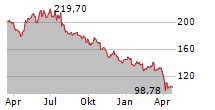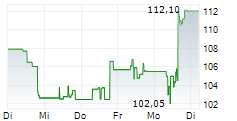CAMBRIDGE, Mass., July 25, 2025 (GLOBE NEWSWIRE) -- Biogen Inc. (Nasdaq: BIIB) announced the Committee for Medicinal Products for Human Use (CHMP) of the European Medicines Agency (EMA) adopted a positive opinion recommending marketing authorization for ZURZUVAE® (zuranolone) for the treatment of postpartum depression (PPD) in adults following childbirth. If approved by the European Commission (EC), ZURZUVAE will be the first treatment authorized within the European Union specifically indicated to treat depressive symptoms for women with PPD. ZURZUVAE is a once-daily, oral, 14-day treatment which was approved by the U.S. Food and Drug Administration (FDA) in 2023.
"This is an important milestone for maternal health in the European Union," said Priya Singhal, M.D., M.P.H., Head of Development at Biogen. "ZURZUVAE represents a novel therapeutic approach for the targeted treatment of postpartum depression, with data demonstrating potential for symptom improvement as early as day three of a 14-day course. If approved, this represents a significant opportunity to advance the treatment of a serious condition that remains both underdiagnosed and undertreated."
PPD is one of the most common medical conditions associated with pregnancy.1-3 Symptoms of PPD may include depressed mood, anxiety, affected ability to bond with the newborn, functional impairment of daily activities, feelings of guilt and worthlessness, doubts about motherhood, and thoughts of self- or infant harm.1 Left untreated, PPD symptoms may persist beyond the postpartum period and can lead to prolonged maternal morbidities and repercussions on child development.4-6
In Europe, an estimated 5-20% of women with a pregnancy experience symptoms of PPD.7-12 Because clinical guidelines for screening and management of depression during and after pregnancy vary across European countries, many cases may go undiagnosed and untreated.3 Death by suicide during the perinatal period is a leading cause of maternal mortality in Europe.4, 13
The CHMP's recommendation for ZURZUVAE is based on the SKYLARK Study evaluating ZURZUVAE which met its primary endpoint, a significant mean reduction from baseline in the 17-item Hamilton Rating Scale for Depression (HAMD-17) total score, a common measure of depression severity, at Day 15 as compared to placebo. All key secondary endpoints were also met, with significant reduction in depressive symptoms seen as early as Day 3 and sustained through Day 45 compared to placebo. ZURZUVAE was generally well-tolerated. The most frequently reported side effects = 5% and greater than placebo in patients treated with ZURZUVAE 50 mg were somnolence, dizziness, and sedation.
The CHMP's recommendation for ZURZUVAE will now be reviewed by the EC for marketing authorization in the European Union with a final decision expected in the third quarter of 2025. The U.S. FDA approved ZURZUVAE in August 2023 and the Drug Enforcement Agency (DEA) scheduled it as a Class IV controlled substance on October 31, 2023.
About ZURZUVAE® (zuranolone)
In the U.S., ZURZUVAE® is a once-daily, oral, 14-day medicine for treatment of postpartum depression (PPD) in adults. ZURZUVAE is a neuroactive steroid (NAS) GABA-A receptor positive allosteric modulator (PAM). The GABA system is the major inhibitory signaling pathway of the brain and central nervous system and contributes to regulating brain function.
ZURZUVAE was discovered by Sage Therapeutics, Inc. (Nasdaq: SAGE), and in 2020 Biogen and Sage Therapeutics entered into a collaboration to jointly develop and commercialize ZURZUVAE in the U.S. As part of the agreement, Biogen received exclusive rights to develop and commercialize ZURZUVAE outside of the U.S., excluding Japan, Taiwan and South Korea.
About Biogen
Founded in 1978, Biogen is a leading biotechnology company that pioneers innovative science to deliver new medicines to transform patients' lives and to create value for shareholders and our communities. We apply deep understanding of human biology and leverage different modalities to advance first-in-class treatments or therapies that deliver superior outcomes. Our approach is to take bold risks, balanced with return on investment to deliver long-term growth.
We routinely post information that may be important to investors on our website at www.biogen.com. Follow us on social media - Facebook, LinkedIn, X, YouTube.
Biogen Safe Harbor
This news release contains forward-looking statements, including relating to; the potential, benefits, safety and efficacy of zuranolone (marketed under the brand name ZURZUVAE); the potential of Biogen's commercial business and pipeline programs, including ZURZUVAE; the anticipated benefits and potential of Biogen's collaboration arrangement with Sage; and risks and uncertainties associated with drug development and commercialization. These forward-looking statements may be accompanied by such words as "aim," "anticipate," "assume," "believe," "contemplate," "continue," "could," "estimate," "expect," "forecast," "goal," "guidance," "hope," "intend," "may," "objective," "plan," "possible," "potential," "predict," "project," "prospect," "should," "target," "will," "would," and other words and terms of similar meaning. Drug development and commercialization involve a high degree of risk, and only a small number of research and development programs result in commercialization of a product. Results in early-stage clinical trials may not be indicative of full results or results from later stage or larger scale clinical trials and do not ensure regulatory approval. You should not place undue reliance on these statements. Given their forward-looking nature, these statements involve substantial risks and uncertainties that may be based on inaccurate assumptions and could cause actual results to differ materially from those reflected in such statements.
These forward-looking statements are based on management's current beliefs and assumptions and on information currently available to management. Given their nature, we cannot assure that any outcome expressed in these forward-looking statements will be realized in whole or in part. We caution that these statements are subject to risks and uncertainties, many of which are outside of our control and could cause future events or results to be materially different from those stated or implied in this document, including, among others, uncertainty of long-term success in developing, licensing, or acquiring other product candidates or additional indications for existing products; expectations, plans and prospects relating to product approvals, approvals of additional indications for our existing products, sales, pricing, growth, reimbursement and launch of our marketed and pipeline products; our ability to effectively implement our corporate strategy; the successful execution of our strategic and growth initiatives, including acquisitions; the risk that positive results in a clinical trial may not be replicated in subsequent or confirmatory trials or success in early stage clinical trials may not be predictive of results in later stage or large scale clinical trials or trials in other potential indications; risks associated with clinical trials, including our ability to adequately manage clinical activities, unexpected concerns that may arise from additional data or analysis obtained during clinical trials, regulatory authorities may require additional information or further studies, or may fail to approve or may delay approval of our drug candidates; the occurrence of adverse safety events, restrictions on use with our products, or product liability claims; and any other risks and uncertainties that are described in other reports we have filed with the U.S. Securities and Exchange Commission.
These statements speak only as of the date of this press release and are based on information and estimates available to us at this time. Should known or unknown risks or uncertainties materialize or should underlying assumptions prove inaccurate, actual results could vary materially from past results and those anticipated, estimated or projected. Investors are cautioned not to put undue reliance on forward-looking statements. A further list and description of risks, uncertainties and other matters can be found in our Annual Report on Form 10-K for the fiscal year ended December 31, 2024 and in our subsequent reports on Form 10-Q and Form 10-K, in each case including in the sections thereof captioned "Note Regarding Forward-Looking Statements" and "Item 1A. Risk Factors," and in our subsequent reports on Form 8-K. Except as required by law, we do not undertake any obligation to publicly update any forward-looking statements whether as a result of any new information, future events, changed circumstances or otherwise.
References:
- American Psychiatric Association, Diagnostic and statistical manual of mental disorders (5th ed.). https://doi.org/10.1176/appi.books.9780890425596. 5 ed. 2013, Washington, DC.
- Vigod, S.N., et al., Canadian Network for Mood and Anxiety Treatments 2024 Clinical Practice Guideline for the Management of Perinatal Mood, Anxiety, and Related Disorders: Guide de pratique 2024 du Canadian Network for Mood and Anxiety Treatments pour le traitement des troubles de l'humeur, des troubles anxieux et des troubles connexes perinatals. Can J Psychiatry, 2025: p. 7067437241303031.
- Motrico, E., et al., Clinical practice guidelines with recommendations for peripartum depression: A European systematic review. Acta Psychiatr Scand, 2022. 146(4): p. 325-339.
- The Lancet Regional, H.-E., Support not stigma: redefining perinatal mental health care. Lancet Reg Health Eur, 2024. 40: p. 100930.
- Slomian, J., et al., Consequences of maternal postpartum depression: A systematic review of maternal and infant outcomes. Womens Health (Lond), 2019. 15: p. 1745506519844044.
- Rogers, A., et al., Association Between Maternal Perinatal Depression and Anxiety and Child and Adolescent Development: A Meta-analysis. JAMA Pediatr, 2020. 174(11): p. 1082-1092.
- Clavenna, A., et al., Postnatal depression screening in a paediatric primary care setting in Italy. BMC Psychiatry, 2017. 17(1): p. 42.
- Cena, L., et al., Prevalence of maternal antenatal and postnatal depression and their association with sociodemographic and socioeconomic factors: A multicentre study in Italy. J Affect Disord, 2021. 279: p. 217-221.
- Della Corte, L., et al., Prevalence and associated psychological risk factors of postpartum depression: a cross-sectional study. J Obstet Gynaecol, 2022. 42(5): p. 976-980.
- Pataky, E.A. and U. Ehlert, Longitudinal assessment of symptoms of postpartum mood disorder in women with and without a history of depression. Arch Womens Ment Health, 2020. 23(3): p. 391-399.
- Dekel, S., et al., The dynamic course of peripartum depression across pregnancy and childbirth. J Psychiatr Res, 2019. 113: p. 72-78.
- Holm, D.L., et al., A quantitative comparison of two measures of postpartum depression. BMC Psychiatry, 2022. 22(1): p. 202.
- Diguisto, C., et al., Maternal mortality in eight European countries with enhanced surveillance systems: descriptive population based study. BMJ, 2022. 379: p. e070621.
| MEDIA CONTACT: Allison Murphy + 1 781 464 3260 public.affairs@biogen.com | INVESTOR CONTACT: Tim Power +1 781 464 2442 IR@biogen.com |




